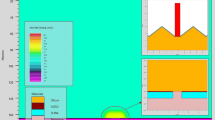Abstract
The work presented in this paper is concerned a detailed study about the light transmission through textured surfaces in a surface made up of pyramids [1, 2]. We investigate to what extent and under what conditions we want to take advantage of ray incidence five times and more [3, 4]. It is found that these analyses can be used to determine the optimal surface texture which provides the best light trapping for solar cells in terms of the total internal reflection occurring in the high-index medium at incidence angles larger than the nominal critical angle [5–11]. One of the main contributions of this paper is the analysis and quantification of the influence of the opening between the heads of the two closest pyramids in textured surface for solar cells and its application on the photovoltaic parameters such as the quantum efficiency. In this model we show that the material can have five and more successive incident ray absorptions instead of three currently, where we changed the direction of the reflected ray, by varying the angle between the two neighbouring pyramids, the incidence angle, the opening between the heads of the two closest pyramids and their height. Thus, with an angle between the two neighbouring pyramid varying between 20° and 12° and for angle of incidence varying between 80° and 84°. For these values of the angle between the two neighbouring pyramids and incidence angle, the opening between the heads of the two closest pyramids varied respectively from 3.53 to 2.10 µm for a pyramid height of 10 µm. This lead to a substantial increase of the quantum efficiency thus the photovoltaic efficiency.
Similar content being viewed by others
References
P. Campbell and M. A. Green, “Light trapping properties of pyramidally textured surfaces,” J. Appl. Phys. 62, 243 (1987).
P. Campbell and M. A. Green, “High performance light trapping textures for monocrystalline silicon solar cells,” Sol. Energy Mater. Sol. Cells 65, 369–375 (2001).
A. Hamel, B. Hadjoudja, and A. Chibani, “Possible improvement of solar cell efficiency,” Phys. Part. Nucl. Lett. 7, 281–284 (2010).
A. Hamel, “The influence of the opening between the heads of the two closest pyramids in textured surface for solar cells and its application on the spectral response,” Phys. Part. Nucl. Lett. 11, 282–285 (2014).
J. Nijs, S. Sivoththaman, J. Szlufcik, K. De Clercq, F. Duerinckx, E. van Kerschaever, R. Einhaus, J. Poortmans, T. Vermeulen, and R. Mertens, “Overview of solar cell technologies and results on high efficiency multicrystalline silicon substrates,” Sol. Energy Mater. Sol. Cells 48, 199–217 (1997).
H. Seidel, L. Csepregi, A. Heuberger, and H. Baumgartel, “Anisotropic etching of crystalline silicon in alkaline solution. Orientation dependence and behavior of passivation layers,” J. Electrochem. Soc. 137, 3612–3626 (1996).
L. A. Dobrzan-ski and A. Drygała, “Surface texturing of multicrystalline silicon solar cells,” J. Achievem. Mater. Manuf. Eng. 31, 77–81 (2008).
M. Lipinski, P. Zieba, and A. Kaminski, “Crystalline silicon solar cells,” in Foundation of Materials Design, Ed. by K. J. Kurzydłowski, B. Major and P. Zięba, Research Signpost (2006), pp. 285–308.
P. Panek, M. Lipiski, and J. Dutkiewicz, “Texturization of multicrystalline silicon by wet chemical etching for silicon solar cells,” J. Mater. Sci. 40, 1459–1463 (2005).
V. Y. Yerokhov, R. Hezel, M. Lipinski, R. Ciach, H. Nagel, A. Mylyanych, and P. Panek, “Cost-effective methods of texturing for silicon solar cells,” Sol. Energy Mater. Sol. Cells 72, 291–298 (2002).
K. Fukui, Y. Inomata, and K. Shirasawa, “Surface texturing using reactive ion etching for multicrystalline silicon solar cell,” in Proceedings of the 26 IEEE Photovoltaic Specialists Conference PVSC’97 (Anaheim, 1997), pp. 47–50.
M. Law, M. C. Beard, S. Choi, J. M. Luther, M. C. Hanna, and A. J. Nozik, “Determining the internal quantum efficiency of PbSe nanocrystal solar cells with the aid of an optical model,” Nano Lett. 8, 3904–3910 (2008).
H. Park, S. Kwon, J. S. Lee, H. J. Lim, S. Yoon, and D. Kim, “Improvement on surface texturing of single crystalline silicon for solar cells by saw-damage etching using an acidic solution,” Sol. Energy Mater. Sol. Cells 93, 1773–1778 (2009).
A. Ricaud, Photopiles Solaires (Presses Polytech. Univ. Romandes, Lausanne, 1997), pp. 195–198.
Author information
Authors and Affiliations
Corresponding author
Additional information
The article is published in the original.
Rights and permissions
About this article
Cite this article
Hamel, A. Improvement of quantum efficiency using surface texture of solar cell in the form of pyramid. Phys. Part. Nuclei Lett. 13, 69–73 (2016). https://doi.org/10.1134/S1547477116010106
Received:
Published:
Issue Date:
DOI: https://doi.org/10.1134/S1547477116010106




